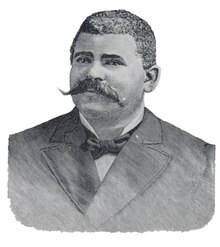William J. Simmons (teacher)
William J. Simmons | |
|---|---|
 | |
| Born | June 29, 1849 |
| Died | October 30, 1890 (aged 41) |
| Occupation(s) | Baptist pastor, educator, activist, author |
| Known for | President and namesake of Simmons College of Kentucky |
William J. Simmons (June 29, 1849 – October 30, 1890) was an American Baptist pastor, educator, author, and activist. He was formerly enslaved person, who became the second president of Simmons College of Kentucky (1880–1890), for whom the school was later named.
Simmons greatly developed
Early life and education
Rev. Dr. William J. Simmons was born into slavery in Charleston, South Carolina, to Edward and Esther Simmons on June 29, 1849. When Simmons was young, his mother fled slavery with her three children, William and his two sisters, Emeline and Anna.
They initially settled in
Career
American Civil War & Hillsdale School
From 1862 to 1864, Simmons served as an
After the war, Simmons returned to dentistry. In 1867, he became a
Howard Academy & Simmons College of Kentucky
In the summer of 1875, Simmons married Josephine A. Silence on August 25, 1874, and moved to
. He served there until 1879.Simmons was
Politics and activism
In Kentucky, Simmons was elected for several years the chairman of the State Convention of Colored Men. On September 29, 1882, he was elected editor of the journal the American Baptist, in which he criticized the failures of both the Republican and
In 1886, Simmons was elected over
Awards
Simmons received an honorary master's degree from Howard University in 1881 and an honorary doctorate degree from Wilberforce University in 1885.[1]
In 1887, he published a book entitled
Death and legacy
Simmons died on October 30, 1890, in Louisville, Kentucky.
Starting in 1891, he was the namesake of the Simmons Colored School in The Ville neighborhood in St. Louis, Missouri.[7]
Bibliography
- Albert Witherspoon Pegues (1892). "William J. Simmons". Our Baptist Ministers and Schools. Willey & Company. pp. 439–.
- Rev William J. Simmons (1887). Men of Mark: Eminent, Progressive and Rising. G. M. Rewell & Company.
References
- ^ a b c d e f Simmons, Rev. William J. (1887). Men of Mark: Eminent, Progressive, and Rising. Cleveland, Ohio: Geo. M. Rewell & Co. pp. 39–63.
- ^ "Compiled Military Service Records of Volunteer Union Soldiers Who Served with the United States Colored Troops: Infantry Organizations, 41st through 46th", The National Archives, Publication Number: M1994, National Archives Catalog ID: 300398, Roll: 0013, access on fold3 on August 16, 2016
- ^ Louise Daniel Hutchinson and Gail Sylvia Lowe (1983). "Solomon G. Brown:A Renaissance Man". Kind Regards of S.G. Brown: Selected Poems of Solomon G. Brown (PDF). Washington D.C.: Anacostia Neighborhood Museum of the Smithsonian Institution by the Smithsonian Press. pp. 3–5.
- ^ Richings, G. F. Evidences of progress among colored people. GF Ferguson, 1903. p. 57–59
- ^ Washington, James Melvin, The Making of a Church with the Soul of a Nation, 1880–1889, in eds West, Cornel, and Eddie S. Glaude, eds. African American religious thought: An anthology. Westminster John Knox Press, 2003. p419
- ^ "Baptists Advocate an Exodus", The Indianapolis News (Indianapolis, Indiana) September 19, 1899, p. 1, accessed October 12, 2016
- ^ "National Register of Historic Places Inventory/Nomination: Simmons Colored School" (PDF). National Park Service. Retrieved October 30, 2023. With accompanying pictures
External links
- Men of Mark: Eminent, Progressive and Rising. Cleveland, Ohio: Geo. M. Rewell, 1887.
- Smith, Jessie Carney (editor). Notable Black American Men, Detroit, Michigan: Gale Research Incorporated, 1999, pp. 1066–1077.
